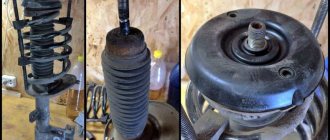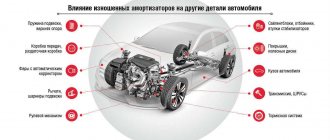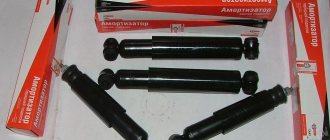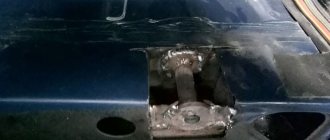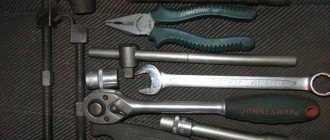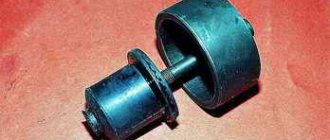In order for the VAZ “Seven” to be driven not only conveniently, but also safely, the condition of the suspension must be periodically monitored. An important element in its design are shock absorbers, which can be replaced by every owner of this car.
- Purpose
Table: parameters of standard front shock absorbers VAZ 2107
- Shock absorber malfunctions
Oil leakage
- Body rocking
- Body roll
- Suspension noise
- Uneven or increased tire wear
- Plunging when braking
- Broken fastening
- Checking shock absorbers on a stand
Video: diagnostics of car dampers on a stand
- Selection of shock absorbers
Oily
- Video: replacing front end dampers on classic Zhiguli cars
- Bleeding oil shock absorbers
Replacing front shock absorbers on VAZ 2101-VAZ 2107
Welcome! Car shock absorbers - how the car will behave in the future on smooth and uneven roads depends only on them.
Over time, car shock absorbers deteriorate and therefore need to be replaced. In this article, we have written detailed instructions on how you can replace the front shock absorbers on cars of the “Classic” family. Note! To perform the replacement, you will need the following tools: First, be sure to stock up on a set of basic wrenches and new shock absorbers. And also, if you have one, take with you a special key for removing shock absorbers; for clarity, it is shown in the figure below:
Question? Which shock absorbers do you prefer: “Gas-oil” shock absorbers or conventional “Hydraulic” ones? (Write your answer in the comments)
Summary:
When do you need to change front shock absorbers? They must be replaced if:
- Loss of its properties, that is, loss of efficiency in damping vibrations.
- And it must also be replaced with a new one if it starts to leak and as a result becomes oily.
Note! To properly verify whether the shock absorbers are working or not, you can read the article entitled: “Checking shock absorbers for performance”!
Device Features
Many people equate the concepts of shock absorber and shock absorber strut. Some people think that it is a simple spring, while others correctly call all its components together as a shock absorber strut.
Where is the truth and where is the lie? We'll figure out.
Let's start with the fact that shock absorber struts are a suspension element necessary to connect two important components - the wheels of the car and the body itself. The support is connected to the damper and spring. By the way, the damper is considered the most important component of the shock absorber.
The shock absorber strut or simply AC performs several key functions:
- holds the weight of the machine;
- transfers the force of adhesion to the road surface to the body;
- maintains optimal position of the body in relation to the wheels;
- eliminates excess roll;
- takes on lateral loads.
The price of struts is higher compared to shock absorbers, since their design is complex and higher quality materials are used in production. If you look at the design, speakers are produced with and without springs. Think carefully before you buy.
You need to choose new struts for Ford Focus, Renault Logan, Skoda Octavia, Kia Spectra, as well as cars like VAZ 2110, 2114 or Lada Granta and Priora based on the design features of the suspension and the available budget.
Theoretically, the front and rear struts can simply be called shock absorbers. But I don’t agree with this position. These elements are different from each other. If you can’t see it in the photos and videos, then I’ll tell you. Although the two elements are similar, the strut additionally has a support spring and a tie rod.
The rack includes the following elements:
- Cylinders. They contain a piston and a special hydraulic fluid;
- Hydraulic fluid. It can be represented by a mixture of gas and liquid, or simply a mixture of gases. It is needed to transmit forces between shock absorbers;
- Stock. Holds the piston and is necessary for assembling pushing forces;
- A piston equipped with a bypass valve. It moves inside the cylinder. Needed for smooth transmission of vibrations;
- Oil seals. Sealant and sealant;
- External body. Serves to house all the components of the shock absorber;
- Fasteners. You understand, they are necessary to connect the shock absorbers to the car body.
Alas, even on cars like Kia Sportage, Chevrolet Cruze, Lacetti and Aveo, Renault Logan, various Mitsubishi, Volkswagen and Toyota models, like the domestic Kalina, it is not always possible to operate the car for a long time on the same racks without consequences. Over time, they wear out, break and become unusable.
It is important to notice in time when the speakers are showing signs of fatigue and need to be replaced.
Symptoms of Excessive Wear or Breakage
I will not describe what can happen if the left or right strut breaks. Nothing good will happen, I guarantee you that. Therefore, carefully monitor your car. Timely repair or replacement of racks will avoid problems.
The following characteristic signs indicate a malfunction of the front struts:
- when moving, there is a creaking, clicking and knocking sound;
- the car sways and continues to oscillate from side to side for a long time;
- the car skids heavily when cornering;
- braking requires a longer braking distance than usual;
- the car “squats” when you accelerate or brake (the sensations are observed behind and in front, respectively);
- the car clings to the road worse;
- rubber wears unevenly;
- Brake fluid is leaking from the shock absorbers;
- the spring, supports or rod become corroded;
- the noise level increases during acceleration (most likely, the bushing fasteners are damaged);
- the body is deformed, the piston cannot move normally inside the cylinder;
- The springs are positioned incorrectly, so the body of the car begins to oscillate when moving.
Wear and breakage of racks can occur due to poor quality of the elements themselves, improper installation, or the natural process of wear and aging of the elements.
I cannot say unequivocally which racks are best to buy if replacement is required. Much depends on the budget and the car itself. But the price now is the Kayaba brand, or, as it is correctly called, KYB. Positive reviews and reasonable prices make these racks a worthy choice. But it's up to you.
How to replace front shock absorbers on a VAZ 2101-VAZ 2107?
Note! Both shock absorbers are replaced in the same way, so we will show their replacement only using the example of one shock absorber!
Removal: 1) First drive the car into the inspection hole, or hang it up using a lift.
2) Now open the hood and pick up the special key (If you don’t have it, then use small pliers). Next, place a special wrench on the shock absorber rod, which is indicated by the number “1” in the photo, thereby reducing the likelihood of the rod turning along the axis.
Immediately after this, use a wrench labeled “2” to unscrew and then remove the nut, after the nut, remove the spring washer, as well as the cushion washer and the upper shock absorber mounting cushion itself.
Note! If you are working on a lift, then perform this operation with the car standing on the ground!
3) Then crawl under the car, and there, unscrew the two nuts that secure the bracket to the lever.
Note! Unscrew the nuts carefully, because above them there are spring washers that will also need to be carefully removed. If both lower nuts are soured, then apply WD-40 grease to them, thereby ensuring they can be easily loosened!
4) When both nuts that secure the bracket to the lever are unscrewed, pull down the shock absorber and therefore remove it from the car.
5) When the shock absorber is removed, remove the lower cushion from its rod.
6) Next, holding the bolt from turning with one wrench, with the other, unscrew the nut that secures the bracket to the shock absorber and then remove the bolt, thereby removing the small washer and the bracket itself.
Note! You can install the removed bracket on a new shock absorber if it is missing!
Installation: Installation of a new car front shock absorber is carried out in the reverse order of removal.
Note! Before installing a new shock absorber, pull out the rod all the way. After which, for convenience, you can first put a washer on the rod, then a cushion, and then screw the nut on top!
If you do all the work on a lift, then lower the car to such a state that it touches the ground, in other words, so that its suspension is loaded under the weight of the car itself!
If the shock absorber rod comes out from above but not all the way, then first put the cushion washer on it and then screw the nut on top. When the nut is screwed on, using a lever principle, use a screwdriver or wrench to pull the rod up to the top until it stops!
Additional video clip: To make it easier for you to understand the procedure for replacing shock absorbers, then watch a video clip prepared especially for you just below, in which everything is described and explained in detail.
Source
How to prevent damage to a shock absorber strut?
In order for the shock absorber to work out its declared life, it is worth adhering to some operating rules:
- Regular inspection of not only the struts, but also the entire chassis will help prevent unexpected breakdowns.
- Replacement of shock absorbers must be carried out as planned, according to the manufacturer's regulations, even if there are no noticeable signs of wear.
- If the car owner does not have experience in replacing struts on his own, it is better to contact specialists. You can also consult with them on the issue of choosing new spare parts.
- If there are signs of a breakdown, you should immediately go to a service center for diagnostics and subsequent repairs. A car with faulty suspension is a threat to the safety of not only its owner, but also other road users.
For installation, it is worth purchasing those shock absorbers that meet the operating conditions, even if their cost is higher than those offered by the automaker. The difference in price will be compensated by an increase in service life.
Sequence of action:
- we lift the VAZ 2107 car with a jack from the replacement side (we hang the rear wheel), not forgetting to tighten the hand brake;
- spray WD-40 on the mounting threads and go drink tea. After 15 minutes, the Teflon lubricant penetrates inside, which makes unscrewing easier.
- We begin to unscrew the bottom bolt, holding it on one side and using a ratchet on the other, and then knock the bolt out with a hammer through the plastic plate so as not to damage the thread.
- The bottom edge now dangles freely
- Now we calmly unscrew the upper fastening bolt with a wrench, and, using a pry bar, pry the cylinder to the side and remove it.
Now we move the jack to the second half and repeat the same steps. You can use whatever you want - oil or gas, but be sure to use the same ones in a pair. This is how the rear shock absorbers are replaced.
Front shock absorbers are replaced if the same symptoms occur: knocking and “breakdowns” when the front wheel gets into a hole, or the front suspension gets oily.
The tool you need are keys 6, 13, 17.
The principle of operation of shock absorber struts in a car
The operating principle is based on the conversion of mechanical energy into thermal energy. Oscillations are damped in a liquid (oil) or gas (gas) environment; options for integrated use are possible (such models are called gas-oil models).
Any vibrations and irregularities are absorbed precisely by the shock-absorbing struts
Front steps:
We hang the wheel in front in the same way, then open the hood. There is access to the rod of the front shock absorbers of the VAZ 2107.
- Unscrew the nut using a 17 wrench and holding it with a 6 wrench.
- Then, from below, under the car, we turn out the bracket using a 13-mm open-end wrench and turn it out, and then remove it together with the shock absorber:
- Now we repeat all the steps on the other side, remove the second shock absorber, and then in the reverse order, just install new ones. For some car owners, on the contrary, it is easier to change one side first, so as not to jack the VAZ 2107 four times.
Replacement should ideally be carried out immediately at the front and rear to ensure maximum smoothness, but some “stingy” enthusiasts argue that such a replacement is more expensive.
Source
Front shock absorber VAZ 2107
The suspension design of any car uses shock absorbers to increase the comfort and safety of movement. Since VAZ 2107 shock absorbers, like other suspension elements, are subject to constant loads and fail over time, you need to know how faults manifest themselves and be able to replace the part if necessary.
Purpose
The normal and correct operation of the front suspension of the “seven”, and the rear one too, is ensured by the main structural elements - a spring and a shock absorber. The spring softens the shocks of the body while the car is moving. When hitting any kind of obstacle (potholes, bumps), the wheel comes off the road, and thanks to the elastic element it returns to work. When the wheel hits the surface, the body presses down with its entire mass, and the spring should make this contact as soft as possible. The work of the shock absorber is aimed at dampening vibrations of the elastic element as quickly as possible when the body rocks. The part is completely sealed and, when fully operational, is capable of absorbing about 80% of impact energy. The shock absorbers of the front suspension of the VAZ 2107 are attached with the lower eye through the bracket to the lower suspension arm. The damper rod is fixed through the support glass using a nut.
Table: parameters of standard front shock absorbers VAZ 2107
| vendor code | Rod diameter, mm | Case diameter, mm | Body height (excluding stem), mm | Rod stroke, mm |
| 21012905004, 21012905402 | 12 | 41 | 215 | 112 |
Device
The front end of the VAZ 2107 comes from the factory with oil-filled twin-pipe shock absorbers. Structurally, in addition to the flask, piston and rod, they have another cylinder with a flask containing liquid and a piston element. During operation, the liquid is compressed by the piston, which causes it to flow through the valve into the outer cylinder. As a result, the air is further compressed. During rebound, due to the opening of the valves on the piston, the liquid flows back into the inner cylinder. This design of shock absorbers, although simple, has certain disadvantages. Since liquid from one flask to another passes through valves under high air pressure, aeration occurs, during which the liquid mixes with air, causing its properties to deteriorate. In addition, due to two flasks, the damper is cooled worse, which reduces its efficiency.
Shock absorber malfunctions
Any car malfunction always manifests itself in the form of extraneous noise, unusual behavior of the vehicle or other signs. Problems with shock absorbers also have certain symptoms, and if they are detected, you should not delay replacing the dampers.
Oil leakage
The most common sign that a shock absorber has become unusable is a fluid leak. Leaks on the body indicate a loss of seal in the oil reservoir. As a result, not only leaks occur, but also air leaks. In this case, the damper rod has free movement, i.e. it moves without any effort, and the part loses its functionality. If signs of smudges have just appeared on the shock absorber, it will serve a little longer, but you should not leave it without attention and it is better to replace it in the near future.
Body rocking
Since springs and shock absorbers work together to dampen vibrations that occur when driving over bumps, contact with the road may be lost if the damper fails. In this case, shaking increases, the body sways, and the level of comfort decreases. The car becomes rolly, and when it hits obstacles it sways for some time. The easiest way to check the shock absorbers of your “seven” is to press the wing, try to rock the body, and then release it. If the car continues to swing on the springs for some time, then this is a clear sign of a faulty damper.
Body roll
One symptom that indicates problems with the suspension shock absorbers is body roll when cornering. This behavior of the car negatively affects safety, since the quality of braking, as well as vehicle control, suffers. If liquid has leaked from the damper, it will be quite difficult to keep the car turning, which is especially dangerous in winter. When the mileage of the products in question is more than 60 thousand km, which also depends on the quality of the parts themselves and the operating conditions of the vehicle, handling may noticeably deteriorate. But since the process does not occur at one moment, but gradually, the driver practically does not notice this and rolls can be perceived as a normal phenomenon.
Suspension noise
Extraneous sounds in the suspension, uncharacteristic of its operation, indicate the need to check and service this mechanism. When dampers and their bushings wear out, the ability to effectively support the weight of the machine is lost. In addition, so-called shock absorber breakdowns often occur.
Suspension breakdowns are metal elements touching each other, which leads to a knocking sound.
Uneven or increased tire wear
If it has been noticed that the tire tread has uneven wear or wears off too quickly, then this is a clear sign of problems with the suspension. With faulty shock absorbers, the wheel moves vertically with a much greater amplitude, which leads to uneven tire wear. When driving, extraneous noise appears on such wheels.
Plunging when braking
Among car owners there is such a thing as “the car bites.” If the dampers fail, the front of the car will dive during braking, and the rear will sag when accelerating. This is explained by the fact that parts that have become unusable do not cope with their function, that is, they do not support the weight of the machine.
Broken fastening
One of the infrequent breakdowns of the front shock absorbers is the breakage of the lower eye. The reasons for this phenomenon may be different:
- installation of low-quality parts;
- making changes to the standard suspension design.
Sometimes it happens that the fastening of the rod along with the glass breaks off. This phenomenon is accompanied by a knocking sound while driving. It is quite easy to identify a breakdown by opening the hood and looking at the place where the upper part of the shock absorber is attached.
The problem is resolved by welding. Some Zhiguli owners reinforce this part of the body with additional metal elements.
Checking shock absorbers on a stand
The most accurate method for diagnosing shock absorbers is to test the car suspension on a vibration stand. Using such equipment, the properties of each damper are checked separately. At the end of the diagnostics, the device will display a diagram based on the results of measurements of axial vibrations. By comparing the diagram with the permissible vibration value of a working damper, you can understand the condition of the parts.
FakeHeader
Comments 18
crappy oil... the shock is checked by machine, not by hand. although according to the symptoms the left one is a corpse. And then, are the shock absorbers oil or gas oil? plus, as a rule, performance is not the main criterion, the main criterion is the presence of oil in the shock absorber... there is no point in lubricating the silent parts with oil, they should not rotate at all when in place. like the metal bushing in the rubber band... looking at the rubber in general, a question arises. how did you travel? With such silents, the bridge dangles like shit from an ice hole, the car jerks from side to side when pedaling the accelerator.
Replacing the front shock absorber on the “seven”
When damaged, front suspension dampers are usually replaced with new ones. Sometimes owners try to repair them on their own, which requires some experience, the purchase of a repair kit and special oil, but only dismountable shock absorbers are suitable for such a procedure. Before you start replacing, you need to decide which elements to install on your car.
Selection of shock absorbers
The question of choosing dampers for the “seven” is quite difficult for many, which is due to the wide variety of such products. The following types of shock absorbers can be installed on the “classic”:
- oil;
- gas-oil with constant hardness;
- gas-oil with variable hardness.
Each type is characterized by its pros and cons and is produced by different manufacturers. It is necessary to select a product based on the operating conditions of the vehicle and the driving style of the owner.
Oily
Although the “seven” is basically equipped with oil shock absorbers filled with hydraulic fluid, many are not satisfied with their performance. The main disadvantage of such dampers is their slow response. If the car moves at high speed, the shock absorber does not have time to return to working condition, which leads to swaying on the springs. Therefore, they are recommended for those owners who do not operate their cars at speeds exceeding 90 km/h.
Gas-oil
Gas-oil shock absorbers use oil and gas, which increases the operating efficiency of the product and improves handling of irregularities. The main working medium is oil, and gas stabilizes operation by removing excess foam and increasing the efficiency of response to changes in road conditions. Equipping Zhiguli cars with such dampers has a positive effect on driving performance. There is virtually no sway at relatively low speeds. Among the minuses, it is worth highlighting omissions during sharp impacts.
Gas-oil with variable hardness
On the “Seven”, as well as on other “classics”, such elements are practically not installed, which is due to the high price. Products of this type are equipped with a special valve with an electromagnet. By means of the valve, it is adjusted to the operating mode of the vehicle and the amount of gas in the main cylinder of the damper is adjusted with a change in the rigidity of the device.
Video: types of shock absorbers and their differences
Manufacturers
During repairs, many owners install standard elements. Those who want to improve the performance of the suspension purchase gas-oil components. However, you have to choose from foreign manufacturers, since domestic ones do not produce such products. The most popular brands include:
Table: analogues of front dampers for VAZ “classics”
| Manufacturer | vendor code | price, rub. |
| KYB | 443122 (oil) | 700 |
| KYB | 343097 (gas) | 1300 |
| Fenox | A11001C3 | 700 |
| SS20 | SS20177 | 1500 |
| Sachs | 170577 (oil) | 1500 |
How to remove
To dismantle a faulty shock absorber we will need:
The event consists of the following actions:
- We hang the front of the car using a jack.
- Open the hood, unscrew the upper shock absorber mount in the mudguard hole using a 17 key, holding the rod with a 6 key.
Video: replacing front end dampers on classic Zhiguli cars
How to prepare for installation
The process of installing shock absorbers on a VAZ 2107 does not cause any difficulties. However, for proper and long-term operation they need to be prepared - pumped. Since the procedure differs depending on the type of device, we will dwell in more detail on the preparation of each of them.
Bleeding oil shock absorbers
We pump oil-type dampers according to the following algorithm:
- We install the product with the stem down and gradually compress it.
- We wait a few seconds, holding the part with our hands in the same position.
Bleeding gas shock absorbers
The procedure for dealing with gas dampers is as follows:
- Turn the part over with the stem down.
- Smoothly recess the rod and fix it for a few seconds.
- Turn the product over again and hold for no more than 6 seconds.
- Fully extend the stem.
- We turn the part over, pause for a couple of seconds and repeat steps 1–4 several times.
- We finish pumping at step 4.
- To check the performance of the part, perform step 7 on pumping the oil shock absorber.
Video: preparing gas-oil shock absorbers for operation
How to put
It is recommended to fully extend the rod before installing the shock absorber. If the damper was removed due to wear of the rubber pads or silent block, we replace them with new ones. Installation is carried out in the reverse order of removal.
If the front shock absorber of your "seven" fails, you do not have to contact a service center for help - the repair can be done on your own without special tools and extensive experience in carrying out procedures of this kind. To replace the damper, it is enough to familiarize yourself with the algorithm of actions and follow them during operation.
Source

